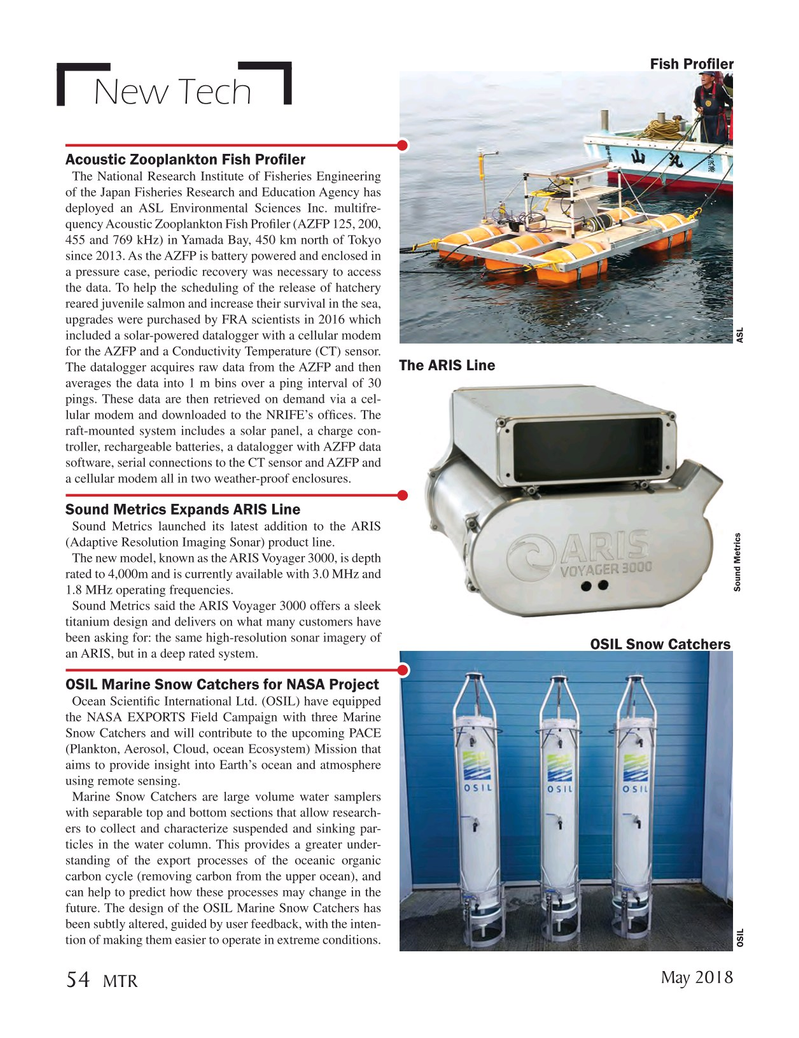
Page 54: of Marine Technology Magazine (May 2018)
Hydrographic Survey: Single beam and Multibeam Sonar
Read this page in Pdf, Flash or Html5 edition of May 2018 Marine Technology Magazine
Fish Pro? ler
New Tech
Acoustic Zooplankton Fish Pro? ler
The National Research Institute of Fisheries Engineering of the Japan Fisheries Research and Education Agency has deployed an ASL Environmental Sciences Inc. multifre- quency Acoustic Zooplankton Fish Pro? ler (AZFP 125, 200, 455 and 769 kHz) in Yamada Bay, 450 km north of Tokyo since 2013. As the AZFP is battery powered and enclosed in a pressure case, periodic recovery was necessary to access the data. To help the scheduling of the release of hatchery reared juvenile salmon and increase their survival in the sea, upgrades were purchased by FRA scientists in 2016 which included a solar-powered datalogger with a cellular modem for the AZFP and a Conductivity Temperature (CT) sensor.
The ARIS Line
The datalogger acquires raw data from the AZFP and then averages the data into 1 m bins over a ping interval of 30 pings. These data are then retrieved on demand via a cel- lular modem and downloaded to the NRIFE’s of? ces. The raft-mounted system includes a solar panel, a charge con- troller, rechargeable batteries, a datalogger with AZFP data software, serial connections to the CT sensor and AZFP and a cellular modem all in two weather-proof enclosures.
Sound Metrics Expands ARIS Line
Sound Metrics launched its latest addition to the ARIS (Adaptive Resolution Imaging Sonar) product line.
The new model, known as the ARIS Voyager 3000, is depth rated to 4,000m and is currently available with 3.0 MHz and
Sound Metrics 1.8 MHz operating frequencies.
Sound Metrics said the ARIS Voyager 3000 offers a sleek titanium design and delivers on what many customers have been asking for: the same high-resolution sonar imagery of
OSIL Snow Catchers an ARIS, but in a deep rated system.
OSIL Marine Snow Catchers for NASA Project
Ocean Scienti? c International Ltd. (OSIL) have equipped the NASA EXPORTS Field Campaign with three Marine
Snow Catchers and will contribute to the upcoming PACE (Plankton, Aerosol, Cloud, ocean Ecosystem) Mission that aims to provide insight into Earth’s ocean and atmosphere using remote sensing.
Marine Snow Catchers are large volume water samplers with separable top and bottom sections that allow research- ers to collect and characterize suspended and sinking par- ticles in the water column. This provides a greater under- standing of the export processes of the oceanic organic carbon cycle (removing carbon from the upper ocean), and can help to predict how these processes may change in the future. The design of the OSIL Marine Snow Catchers has been subtly altered, guided by user feedback, with the inten- tion of making them easier to operate in extreme conditions.
OSIL ASL
May 2018 54
MTR
MTR #4 (50-63).indd 54 MTR #4 (50-63).indd 54 5/10/2018 12:27:03 PM5/10/2018 12:27:03 PM

 53
53

 55
55
